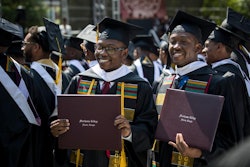It is possible that in the very near future, a doctor will be able to take a blood sample — or even a piece of toenail — from a person and tell everything about who they are biologically.
This and other knowledge about the genetic connection to disease is unfolding everyday through the Human Genome Project (HGP), a federally funded national research effort to map the entire human deoxyribonucleic acid (DNA). The project started in the mid 1980s as a result of work done by the Atomic Energy Commission on the effects of radiation on the human body. The study also looked into energy related technologies, according to Dr. Dan Drell, a biologist in the Department of Enery, which now heads the research. Scientists at the National Institutes of Health (NIH), believing that the research could help pinpoint the genetic origins of disease, got involved in the project also.
HGP is now a $3 billion, fifteen-year project based at three national centers: The Lawrence Berkeley Laboratory and The Lawrence Livermore Laboratory in California, and The Los Alamos Laboratory in New Mexico. Research is also being done at several smaller labs, at non-profit agencies, at small businesses, and at colleges and universities.
Approximately fifty universities and academic centers nationwide are engaged in some phase of the project. Internationally, there is a center in Canada at the University of Alberta and the Japanese have begun their own project. The different components include: physical mapping, sequencing, instrumentation development, infomatics (computational biology), and ELSI (Ethical, Legal and Social Implications).
The Importance of HBCU Involvement Morehouse School of Medicine, the only HBCU to have been funded to participate in the project did a study from 1992 to 1994 on the ethical implications of the technologies arising from genetic study. Howard University is receiving funds to collaborate with and develop resources for other investigators.
Howard is also receiving funds through NIH to develop its own genome laboratory. Dr. Ed Smith, professor of animal generatics in the College of Agriculture, Environmental and Natural Science at Tuskegee University, recently hosted a human genome conference which centered around ELSI issues.
One of the reasons for the conference was to expose Tuskegee genetics students to the scientists in the genome centers and to get them participating in and collaborating with some of the research. “My lab is also trying to develop a collaborative program with Stanford and other academic centers because a spinoff of the human genome project is that it is leading to more understanding about animal genetics, too. The techniques are the same,” says Smith.
“We’ve struggled in this area” of funding HBCUs to participate in the project, says Drell, “because we require applicants go through peer review. But peer review is not as much of a problem as it is that we do not get many applications to begin with.”
Dr. Georgia Dunston, professor of microbiology at the Howard University College of Medicine, notes, “We do have a scientific dilemma because the way the HGP is designed, you have to have had the infrastructure in place to toe competitive for the kinds of projects that they wanted to support and you are not likely to find an HBCU with the research infrastructure to compete for the centers.
It is important that there be minority input in the HGP, says Dr. Robert Murray, chief of the division of medical genetics in the department of pediatrics and child health at Howard University’s College of Medicine.
“While the genetic content will be very similar in the human genome, as important as the genes is the way they are arranged. And the way they are arranged ends up making small differences,” says Robert Murray, adding that those small differences could be important. “One of the big questions people have raised is: whose genome would be considered the baseline?”
Dunston agrees, saying, “We know from our current science that the core set of reference resources [DNA samples from Caucasian families] that are going to be used in the studies are not going to be broadly representative of the human genome diversity.”
However, Drell says that the nature of the genome is very unifying for mankind. “I don’t think we’ll ever be able to read out what someone is just from his genome. Certain things, such as gender, we will be able to tell But most other characteristics get enough influences from environment, interactions with other genes, and chance events during embryonic development that we’d have an impossible time reading out what someone is from his or her genome.
Some scientists suggest that a human genome diversity project should compliment the original human genome project, Dunston says. They feel this would be the way to get information on the diversity while keeping the current project narrowly focused.
Dr. Thomas Murray, professor of biomedical ethics at Case Western University and author of “The Human Genome Project and the Future of Health Care,” said that if minorities take a leading role in the research, it would less likely be insensitive. His worry is that harmful enterprises will be undertaken if the people who are potentially going to be harmed have no voice in the planning and execution of the research.
Ethical, Legal and Social Issues
“The Ethical, Legal and Social Issues phase of the genome project was developed because we recognize that knowing some of the information about what is in a person’s genes is not always neutral information,” admits Drell.
The federal government set up a commission to look at how minority groups might be affected by the breakthroughs and discriminatory issues raised by the project. Issues involved include discrimination: in the workplace; in getting insurance coverage; against racial and ethnic groups based on a belief that they are genetically inferior; and in other ways based on genetic predispositions.
DOE offers grants to hold conferences to discuss ELSI issues. Smith said concern about these issues and how they impact the African-American community — as well as an interest in developing opportunities for his genetics students — made him write a proposal for a grant from DOE to host the first HGP conference at an HBCU.
The conference brought together the leading scientists from HGP centers and academic institutions around the country. While it did focus heavily on the ELSI, it did discuss the progress of scientific findings in the project.
“We need to increase awareness of this program in the African-American community because information coming out of the human genome project could be used and misused,” cautions Smith.
“One of the things we do need to be concerned with is the human inclination to explain group differences in genetic terms — whether or not there is really any genetic basis for them. Western culture has a history with genetic explanation and the history is a pretty bleak one,” says Thomas Murray, who participated in the conference.
Illustrates Murray: “In the past, people have used genetic explanations to maybe explain that because a group of people are not faring as well economically as the rest of society that it is because of genetic differences in IQ rather than face or believe that their society discriminates. So the challenge posed by the HGP is to keep vigorous commitments to moral, legal and political equality in the face of growing evidence about individual and group genetic differences.”
Dr. David Botstein, professor of genetics at Stanford University School of Medicine, says concerns and fears of abuse about linking things like group differences in athletic ability and intelligence to genes are not only remotely likely, they are actually technically impossible by any foreseeable method.
Botstein says he thought while ELSI concerns are valid, the conference needed to be more focused on the fact that the goal of HGP is to create products that are going to be useful to human health.
Despite the potential for abuse, the possible benefits should make us want to try to find ways to use the research positively, says Smith. “We also need to try to increase awareness of the possible benefits of this program to African Americans with diseases like sickle cell, breast cancer, et cetera. Already, the genetic test for breast cancer and several other types of cancers is available.
Diabetes is coming up, and sickle cell is on the horizon,” Smith adds. The HGP has spilled over and created the need for computers to speed up and manage the mass of information–equal to 200 hundred phone books for each human genome, according to Drell.
“We have also seen, from the HGP, elucidation of new disease-causing mechanisms and impetus for a whole sector of the biotechnology industry,” claims Drell. “The project will create an enormous resource for researchers and lots of new technologies are being developed with lots of good discoveries along the way,” says Thomas Murray. “Many of the results of the genome project won’t actually be listed as direct results. It’s like somebody built an enormous and very sophisticated library for researchers to use who have specific interest in certain diseases.”
COPYRIGHT 1996 Cox, Matthews & Associates
© Copyright 2005 by DiverseEducation.com


















